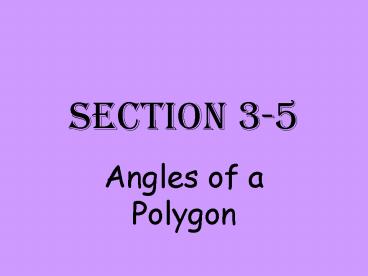Angles of a Polygon PowerPoint PPT Presentation
Title: Angles of a Polygon
1
Section 3-5
- Angles of a Polygon
2
Polygon
- Means many-angled
- A polygon is a closed figure formed by a finite
number of coplanar segments - a. Each side intersects exactly two other sides,
one at each endpoint. - b. No two segments with a common endpoint are
collinear
3
Examples of polygons
4
Two Types of Polygons
- Convex If a line was extended from the sides of
a polygon, it will NOT go through the interior of
the polygon.
5
- 2. Nonconvex If a line was extended from the
sides of a polygon, it WILL go through the
interior of the polygon.
6
Polygons are classified according to the number
of sides they have.
- Must have at least 3 sides to form a polygon.
- Special names
- for Polygons
n stands for number of sides.
7
Diagonal
- A segment joining two nonconsecutive vertices
The diagonals are indicated with dashed lines.
8
Definition of Regular Polygon
- a convex polygon with all sides congruent and all
angles congruent.
9
Interior Angle Sum Theorem
- The sum of the measures of the interior angles of
a convex polygon with n sides is
10
One can find the measure of each interior angle
of a regular polygon
- Find the Sum of the interior angles
- Divide the sum by the number of sides the regular
polygon has.
11
One can find the number of sides a polygon has if
given the measure of an interior angle
12
Exterior Angle Sum Theorem
- The sum of the measures of the exterior angles of
any convex polygon, one angle at each vertex, is
360.
13
One can find the measure of each exterior angle
of a regular polygon
One can find the number of sides a polygon has if
given the measure of an exterior angle
PowerShow.com is a leading presentation sharing website. It has millions of presentations already uploaded and available with 1,000s more being uploaded by its users every day. Whatever your area of interest, here you’ll be able to find and view presentations you’ll love and possibly download. And, best of all, it is completely free and easy to use.
You might even have a presentation you’d like to share with others. If so, just upload it to PowerShow.com. We’ll convert it to an HTML5 slideshow that includes all the media types you’ve already added: audio, video, music, pictures, animations and transition effects. Then you can share it with your target audience as well as PowerShow.com’s millions of monthly visitors. And, again, it’s all free.
About the Developers
PowerShow.com is brought to you by CrystalGraphics, the award-winning developer and market-leading publisher of rich-media enhancement products for presentations. Our product offerings include millions of PowerPoint templates, diagrams, animated 3D characters and more.

